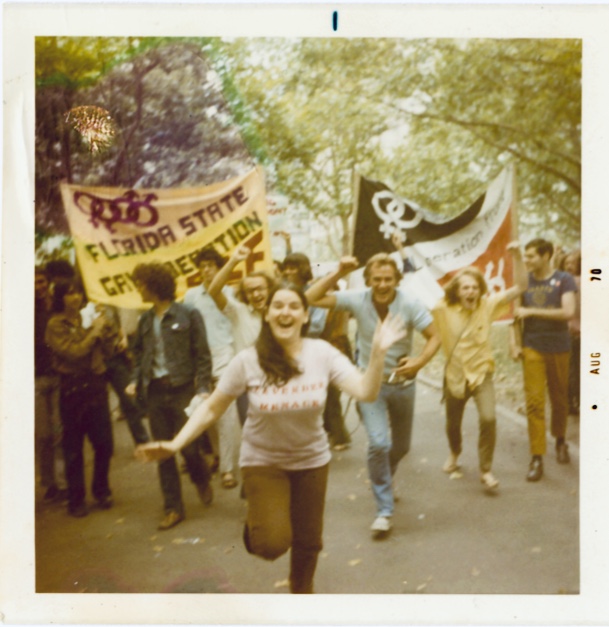
Lesbian and civil rights activist Susan Silverman, whose activism spanned over five decades, passed away in the early morning on August 24. She was 73 years old. Silverman had been a resident of the John C Anderson LGBT-Friendly Apartments on Locust Street since 2014.
Silverman was born at Brooklyn Jewish Women’s Hospital on February 24, 1949. The daughter of unionists and the sister of a Freedom Rider, her activism began with groups including the New York Radical Women, which protested the Miss America Pageant in 1968 due to its stereotypical treatment of women. That year, Silverman came out at 19 years old.
She was living on Manhattan’s Lower East Side and working on the steering committee at Alternate U, a lecture hall and meeting space, when the Stonewall Riots took place in June 1969.
“I was politicized by the civil-rights and anti-war movements. I came out in a flurry of political activity with incredible support. It was an exciting, electric time,” she told PGN in 2014. “My generation really was committed to making change.”
In the weeks after Stonewall, Silverman copied fliers and secured meeting space at Alternate U for the first meeting of what became Gay Liberation Front. She then became a member of GLF and Gay Youth, speaking out and working for LGBT rights while continuing her work on women’s rights. From there, she joined lesbian liberation group popularly referred to as the Lavender Menace and organized the group Radicalesbians with other LM members.
“Gay Liberation Front was a catalyst for a lot of other important groups that then grew out of it,” Silverman said. “We all went into directions that interested us and built on it.”
To help raise money for GLF, Silverman put forward the idea of Alternate U hosting LGBT dances, which had been limited at that time to mafia-controlled clubs like Stonewall.
“I remember Susan at 18, when we were members of GLF and Gay Youth New York,” PGN Publisher Mark Segal said. “She was a firecracker then and still was. Through her role in GLF, she helped shape LGBT identity and helped in creating LGBT community. It is fitting that as she aged she chose to live in an LGBT senior building to continue her activism, which in true GLF fashion, never ends. Even age and poor health didn’t stop her. While she’d debate with you, there always was a smile on her face. I’ll miss our chats about our shared history in those early days, and the joy of watching her tell her story to others.”
As part of Radicalesbians, which rallied against homophobia at the National Organization for Women, Silverman and other members disrupted NOW’s 1970 Second Congress to Unite Women and held a teach-in, telling audiences about their lives and pushing back on people’s misconceptions about lesbians.
“She was a true, true icon of our community,” said Elizabeth Coffey Williams, Silverman’s friend and neighbor at JCAA. “I knew a lot of what she had done, but she was also very humble about it because more than anything, she was my friend; she was my neighbor. We forged a bond almost immediately that was quietly loving and abiding. She was a hard-as-nails, bad-ass Brooklyn broad, and at the same time had the biggest, warmest heart. She was my friend, my sister, my mother, my mentor, and my confidant all at the same time.”
Mary Groce, who also lived with Silverman at JCAA and featured her in the community’s monthly newsletter in 2019, recalled how friendly her neighbor was.
“Susan was such a good friend and, always, a Lavender Menace. We‘ll miss her every day. She welcomed us home our first day here, and we’ve been fast friends ever since. Kindred spirits.”
In addition to her activism, Silverman earned an MSW from Fordham University and worked as a social worker, focusing on people who experienced child abuse and those with bereavement issues. After retiring in 2010, Silverman helped organize Gay Liberation Front’s 40th anniversary march, and she joined fellow GLF members to celebrate the 50th anniversary of Stonewall in 2019.
As a young activist in the ‘70s, Silverman said she and her peers could never have imagined a building like the John C. Anderson Apartments, which gives older LGBTQ people a safe, welcoming, and affordable place to live.
“We had no role models and in lots of different conversations, we would ask what it would be like when we got older,” Silverman told PGN when she first moved in to JCAA. “We would have these fantasies of having a retirement home called Gay-dy Shady Acres. It was a dream that this could happen. I just didn’t think I would be alive to see it.”